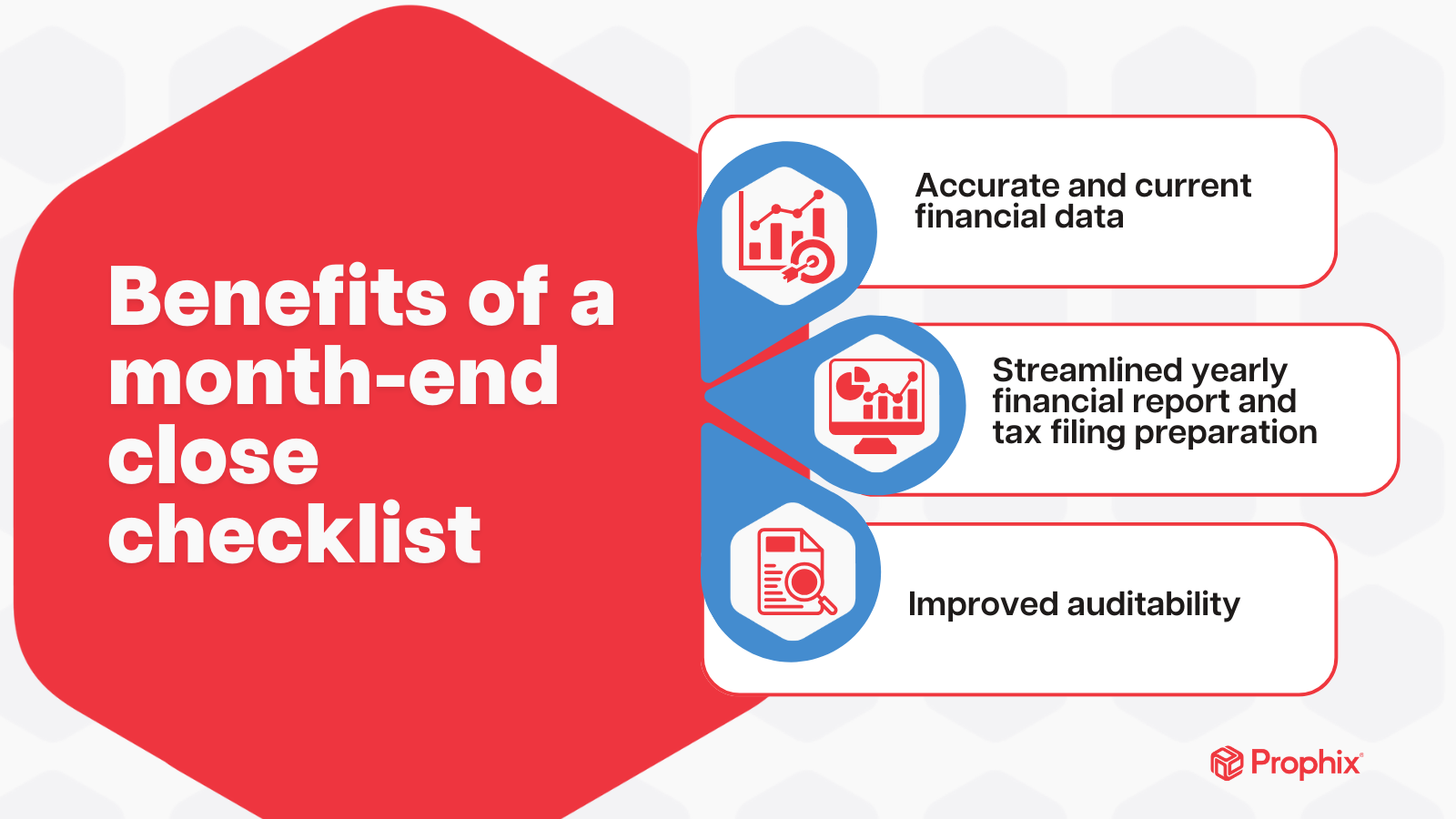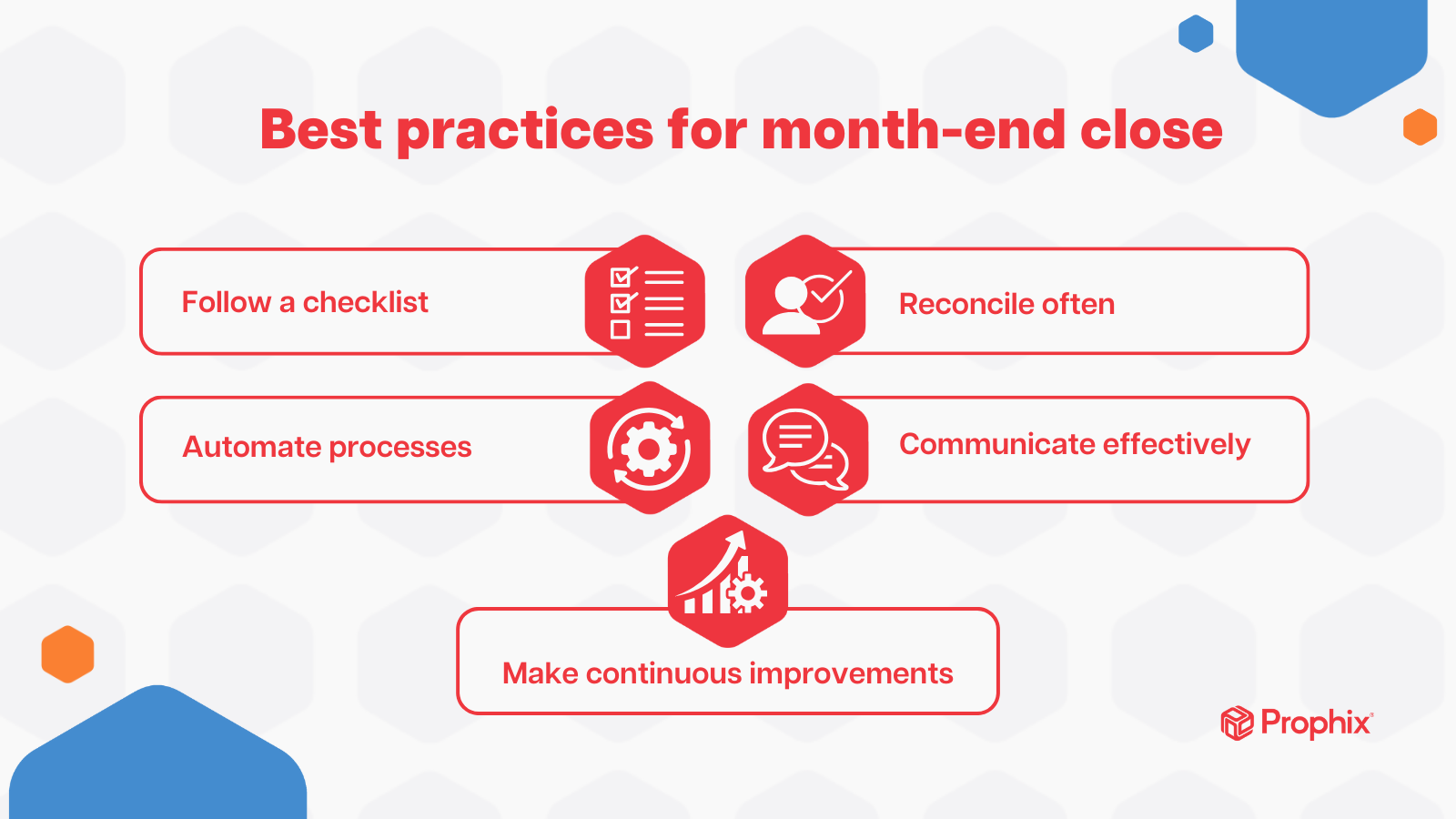The perfect month-end close checklist for finance teams
In the Office of the CFO, efficiency and accuracy are paramount and mastering these qualities is an integral part of perfecting your month-end close process.
In this blog, we’ll guide you through a 10-step checklist designed for finance teams so you can avoid common errors, experience the benefits of a faster process, and implement best practices. We will cover:
- What is a month-end close checklist?
- The perfect 10-step month-end close checklist for finance teams
- What errors should you resolve during a month-end close process?
- Benefits of a month-end close checklist
- Common mistakes during the month-end close process
- Best practices for the month-end close
- Conclusion: Close the books faster with Prophix
What is a month-end close checklist?
Month-end close involves reviewing and reconciling all transactions from the previous month.
A month-end close checklist is a set of checks and processes to ensure your month-end close is accurate, auditable, and streamlined. This checklist should allocate tasks to specific categories, include information on who is preparing and reviewing the report, and allow stakeholders to review your financial statements.
What's the importance of having a month-end close checklist?
A month-end close checklist is important because it allows finance teams to track business transactions. A month-end close checklist ensures your data is accurate and complete so it can be effectively analyzed for trends or anomalies.
An effective month-end close process also sets the stage for an accurate and streamlined year-end close. With each months’ financials prepared, you can analyze your growth year-over-year and make data-driven decisions.
Why should you use a month-end close checklist?
Month-end close checklists can help address any duplicate data, unstructured and manual processes, and missing information, as stakeholders must carefully review the prior months’ transactions, resulting in reduced errors, improved reporting, and more efficient processes.
A checklist can also ensure you don't miss any critical steps during the process, which may only become apparent once several months have passed, especially when multiple stakeholders are involved.
Additional benefits of a month-end close checklist include:
- Accurate and current financial data.
- Streamlined yearly financial reports and tax filings preparation.
- Straightforward audits
Month-end close vs. period close
Month-end close summarizes all financial transactions for the preceding month. Period close is an overarching term that refers to all close processes – year-end, month-end, or quarter-end. As such, month-end close can also be referred to as a period close.

The perfect 10-step month-end close checklist for finance teams
To help you get a head start on your month-end close process, we’ve put together a comprehensive 10-step checklist below.
- Prep your numbers and gather the necessary data
Before you begin, you should collect all the necessary data, including the previous month’s expenses and incoming cash. These expenses include payroll, insurance, loan interest, and supplier payments, and incoming cash includes revenue and investment income. Next, you should ensure your credit and debit entries are posted correctly and that you’ve invoiced all your sales for the prior month. - Update your accounts receivable
For accounts receivable (AR), you should review the invoices you’ve issued for the previous month, with careful attention to duplicate or incorrect invoices. You should also confirm that your customers have paid their invoices and compare those payments against your ledger balances. This can help improve customer relationships and ensure your financial reports are accurate. - Update your accounts payable
Compare your accounts payable (AP) ledger with your AP aging report. This is an opportune time to investigate discrepancies, input pending invoices, and post relevant journal entries. - Prepare account reconciliations
Now that you've reviewed and updated your AR and AP, it's time to reconcile your bank and credit transactions with your general ledger. This is also an ideal time to spot any inconsistencies and correct any missed or wrong transactions. Correct any mistakes by making the necessary journal entries. - Reconcile cash
It’s easy to lose track of petty cash transactions if they’re not carefully recorded. Month-end close is an ideal time to reconcile deposits and receipts and confirm your petty cash balance is what you expect it to be. If you have any cash in transit, remember to note where it's going and why. - Reconcile inventory and fixed assets
If applicable, check what inventory you have on hand and how many products were sold in the last month, and confirm it matches your books. Inventory reconciliation can help ensure you have appropriate storage for your product, you can fulfill next month’s sales, and cover additional inventory-related expenses. - Reconcile payroll and operating expenses
Reconcile your payroll account with your payroll register, including bonuses, commissions, and other benefits. You should also confirm that your payroll entries are posted to the accurate ledger and that you’ve paid the necessary payroll taxes and statutory deductions. Operating expenses include research and development, marketing, office supplies and more. To reconcile your operating expenses, verify your monthly expenses, create an expense report, and post it to the appropriate ledger. - Preliminary and ASC 606 reviews
Review the information related to your income recognition and commissions, whether it's entered by hand or by a computer. Check if it's correct and review it with your team to make sure it's consistent and understandable in all reports. - Conduct variance analysis and adjust
Variance analysis helps you look over and check your monthly and quarterly results at the end of each period. This lets you see how the report aligns with the company's growth targets. If something doesn't look right and needs adjusting, it could become a larger issue over time. - Prepare your financial statements & reports
Now that you’ve reconciled all your accounts, reviewed the results, and eliminated errors, it’s time to prepare your financial statements and month-end close report.
What errors should you resolve during a month-end close process?
There are several errors that you can resolve during the month-end close process, including:
- Remove duplicate data. Unless you have a single source of data truth, your data is likely being entered into more than one system. Collecting, reviewing, and validating this data for the month-end close can be time-consuming and error-prone without a dedicated finance platform to automate these processes.
- Standardize and automate processes. A step-by-step month-end close process is the first step to standardizing your finance processes. Without a set order of operations, month-end close can quickly become challenging to manage, especially if departments outside of finance are involved. Standardized processes discourage employees from taking shortcuts, which could negatively impact your financial reports for several months. The month-end close process can be further streamlined by automating data collection, account reconciliation, and report creation. Automation can also help alleviate the finance team’s workload, allowing them to make strategic recommendations rather than spending time validating entries.
- Expedite your financial data. If your finance team is spending a lot of time preparing your month-end financial report, it may be time to consider investing in a Financial Performance Platform. Late financial data can be a challenge, slowing down the production of monthly reports and impacting decision-making.To expedite your financial data, you must identify any causes of delays, such as lack of training or understanding from other departments.
Benefits of a month-end close checklist
A month-end close checklist is more than just a list - it can bring order, efficiency, and clarity to your financial processes. Here are some of the benefits of using a month-end close checklist:
- Streamline your workflows: With a checklist, you'll know what needs to be done and in which order. This eliminates guesswork, ensuring a smoother, faster close process.
- Reduce errors: A checklist is a double-check system that helps you catch and correct any mistakes or inconsistencies in your financial data. This means more accurate reports that you can rely on.
- Enhance compliance: When using a checklist, you're more likely to meet all regulatory requirements. This can help you avoid penalties and maintain a good reputation with stakeholders.
- Improve your decision-making: The sooner you close your books, the quicker you'll have access to the financial data you need to make decisions. This allows for strategic decisions that can positively impact your business's future.
- Identify future efficiencies: As you continue using the checklist, you'll identify steps that could be automated or improved, leading to greater efficiency over time.
Common mistakes during the month-end close process
Even with the best intentions mistakes can occur during the month-end close process. Being aware of these common errors is the first step towards avoiding them:
- Inadequate preparation: A lack of proper planning often leads to rushed work and errors. This includes not having all the necessary documents ready or not allocating sufficient time for each task.
- Not double-checking entries: It's easy to overlook small errors in data entry. However, even minor inaccuracies can lead to significant discrepancies in your financial statements.
- Ignoring reconciliation: Reconciliation is crucial to ensure that your company's financial records are accurate. Neglecting to reconcile accounts can result in incorrect balances and misleading reports.
- Skipping review steps: Each step in the month-end close process is there for a reason. Skipping steps, like preliminary reviews or variance analysis, can lead to missing critical information or errors.
- Lack of communication: Poor communication between departments can lead to delays or missed information. Ensuring everyone understands their role in the close process is the key to success.
By being aware of these common mistakes, you can better navigate the month-end close process and ensure the accuracy and reliability of your financial reports.
Best practices for month-end close
Here are some best practices to ensure your month-end close is as effective as possible:
- Follow a checklist: A detailed checklist that outlines each step of the process can keep your team focused, ensure all tasks are completed, and prevent anything from falling through the cracks.
- Automate processes: Embrace technology and automate repetitive tasks where you can. This will save time, reduce human error, and allow your team to focus on more strategic activities.
- Reconcile often: Don't wait until the end of the month to reconcile your accounts. Regular reconciliation can help catch and correct errors early, ensuring accurate financial statements.
- Communicate effectively: Ensure clear communication among all departments involved in the close process. Regular updates and reminders can help keep everyone on track and informed.
- Make continuous improvements: Always look for ways to improve your month-end close process. Analyze your current process, identify bottlenecks or areas of inefficiency, and make necessary adjustments.

By adhering to these best practices, you can streamline your month-end close process, making it faster, more accurate, and less stressful for your team.
Conclusion: Close the books faster with Prophix
In conclusion, mastering your month-end close doesn’t have to be complicated. With a dedicated checklist, you can eliminate errors, reconcile accounts, and streamline report creation. By prioritizing regular reviews of your data and communications, your month-end close can go from cumbersome to valuable.
Prophix’s Financial Performance Platform can take your month-end close one step further by automating time-consuming tasks like inter-company eliminations, currency translations, journal entries, report assembly, and distribution. By eliminating manual processes and automating recurring ones, you can spend less time looking back and more time looking forward.
